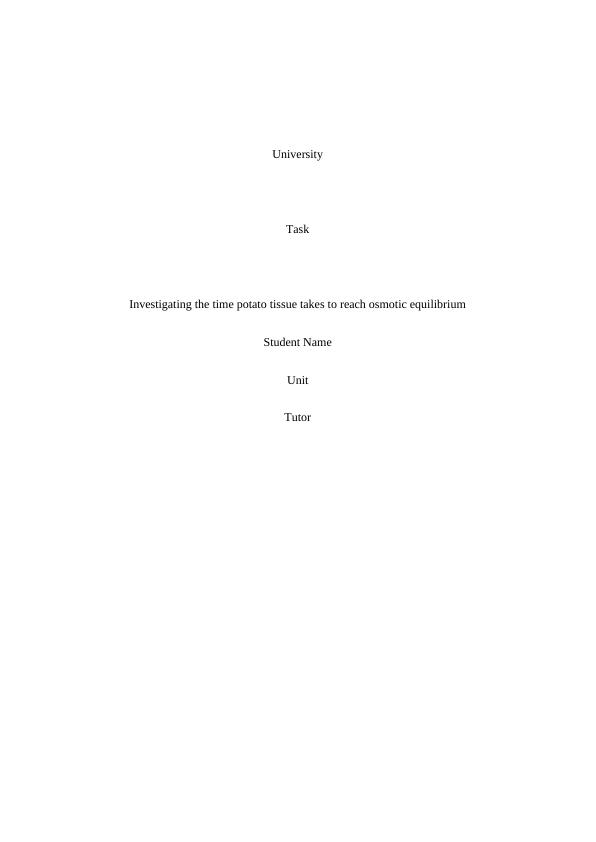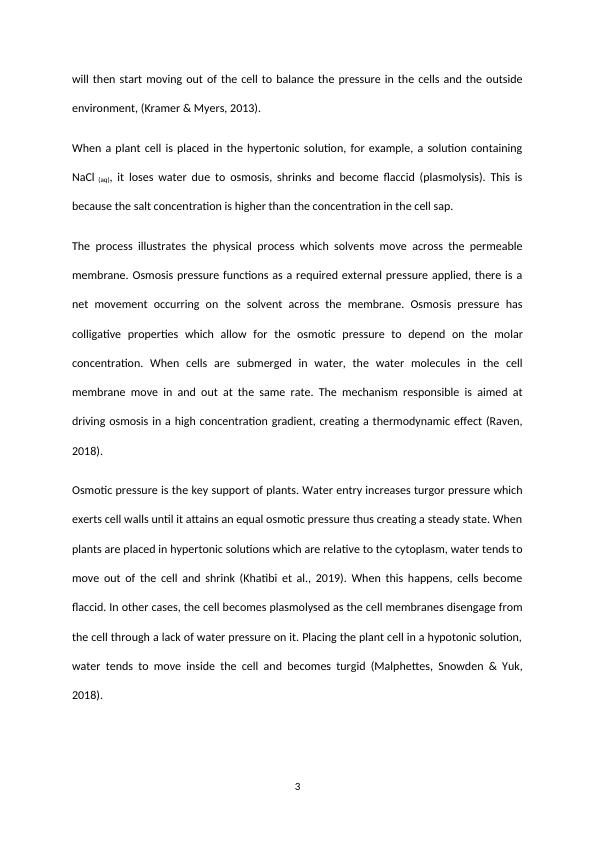Investigating the Time Potato Tissue Takes to Reach Osmotic Equilibrium
Added on 2023-04-23
13 Pages3114 Words96 Views
University
Task
Investigating the time potato tissue takes to reach osmotic equilibrium
Student Name
Unit
Tutor
Task
Investigating the time potato tissue takes to reach osmotic equilibrium
Student Name
Unit
Tutor

Investigating the time potato tissue takes to reach osmotic equilibrium
Aim
To investigate the change in mass in potato strips over a period of two and a half hours
when immersed in a range of solutions from distilled water (hypotonic solution) and salty
water (hypertonic solution).
Research Question
Is 1-hour sufficient time for osmosis in potato tissue?
Background Information
Osmosis is one of the physiological processes in living organisms. It entails the movement of
water molecules from a region of low to high region of solute concentration across the
semi-permeable membrane. Osmosis entails the diffusion of water molecules from high to
lower water concentration across a selectively permeable membrane, in this way the water
movement is achieved down the concentration gradient. The permeability of the membrane
allows smaller substances to penetrate but prevents larger substances moving across the
membrane (Blanco-Marigorta, Lozano-Medina & Marcos, 2017). The cell wall is permeable
thus has no definite role in controlling what enters into the cells. Osmosis is important in
both plants and animals. In plants it makes cells to be turgid or flaccid while in animals it
offsets the osmotic pressures in the cell. Plant cells contain solutes because they have a cell
sap, so when they are put in distilled water (a hypotonic solution), they absorb water by
osmosis, swell up and become turgid (Binding, 2018). They do not burst because they have a
cell wall that develops a wall pressure that balances the turgor pressure used by turgid cells.
As the plant gains turgidity, its volume increases until it achieves maximum turgidity. Water
2
Aim
To investigate the change in mass in potato strips over a period of two and a half hours
when immersed in a range of solutions from distilled water (hypotonic solution) and salty
water (hypertonic solution).
Research Question
Is 1-hour sufficient time for osmosis in potato tissue?
Background Information
Osmosis is one of the physiological processes in living organisms. It entails the movement of
water molecules from a region of low to high region of solute concentration across the
semi-permeable membrane. Osmosis entails the diffusion of water molecules from high to
lower water concentration across a selectively permeable membrane, in this way the water
movement is achieved down the concentration gradient. The permeability of the membrane
allows smaller substances to penetrate but prevents larger substances moving across the
membrane (Blanco-Marigorta, Lozano-Medina & Marcos, 2017). The cell wall is permeable
thus has no definite role in controlling what enters into the cells. Osmosis is important in
both plants and animals. In plants it makes cells to be turgid or flaccid while in animals it
offsets the osmotic pressures in the cell. Plant cells contain solutes because they have a cell
sap, so when they are put in distilled water (a hypotonic solution), they absorb water by
osmosis, swell up and become turgid (Binding, 2018). They do not burst because they have a
cell wall that develops a wall pressure that balances the turgor pressure used by turgid cells.
As the plant gains turgidity, its volume increases until it achieves maximum turgidity. Water
2

will then start moving out of the cell to balance the pressure in the cells and the outside
environment, (Kramer & Myers, 2013).
When a plant cell is placed in the hypertonic solution, for example, a solution containing
NaCl (aq), it loses water due to osmosis, shrinks and become flaccid (plasmolysis). This is
because the salt concentration is higher than the concentration in the cell sap.
The process illustrates the physical process which solvents move across the permeable
membrane. Osmosis pressure functions as a required external pressure applied, there is a
net movement occurring on the solvent across the membrane. Osmosis pressure has
colligative properties which allow for the osmotic pressure to depend on the molar
concentration. When cells are submerged in water, the water molecules in the cell
membrane move in and out at the same rate. The mechanism responsible is aimed at
driving osmosis in a high concentration gradient, creating a thermodynamic effect (Raven,
2018).
Osmotic pressure is the key support of plants. Water entry increases turgor pressure which
exerts cell walls until it attains an equal osmotic pressure thus creating a steady state. When
plants are placed in hypertonic solutions which are relative to the cytoplasm, water tends to
move out of the cell and shrink (Khatibi et al., 2019). When this happens, cells become
flaccid. In other cases, the cell becomes plasmolysed as the cell membranes disengage from
the cell through a lack of water pressure on it. Placing the plant cell in a hypotonic solution,
water tends to move inside the cell and becomes turgid (Malphettes, Snowden & Yuk,
2018).
3
environment, (Kramer & Myers, 2013).
When a plant cell is placed in the hypertonic solution, for example, a solution containing
NaCl (aq), it loses water due to osmosis, shrinks and become flaccid (plasmolysis). This is
because the salt concentration is higher than the concentration in the cell sap.
The process illustrates the physical process which solvents move across the permeable
membrane. Osmosis pressure functions as a required external pressure applied, there is a
net movement occurring on the solvent across the membrane. Osmosis pressure has
colligative properties which allow for the osmotic pressure to depend on the molar
concentration. When cells are submerged in water, the water molecules in the cell
membrane move in and out at the same rate. The mechanism responsible is aimed at
driving osmosis in a high concentration gradient, creating a thermodynamic effect (Raven,
2018).
Osmotic pressure is the key support of plants. Water entry increases turgor pressure which
exerts cell walls until it attains an equal osmotic pressure thus creating a steady state. When
plants are placed in hypertonic solutions which are relative to the cytoplasm, water tends to
move out of the cell and shrink (Khatibi et al., 2019). When this happens, cells become
flaccid. In other cases, the cell becomes plasmolysed as the cell membranes disengage from
the cell through a lack of water pressure on it. Placing the plant cell in a hypotonic solution,
water tends to move inside the cell and becomes turgid (Malphettes, Snowden & Yuk,
2018).
3

Osmosis has the ability to make the plant roots draw water from the soil. The plant absorbs
solutes in the roots through active transport and the water enters the roots through
osmosis. In this experiment, the osmosis effect has been demonstrated by using potato
slices placed in the media under different time frames.
Thus, the aim of this experiment is to assess the effect of hypertonic and hypotonic
solutions on potato over duration of less than two and a half hours.
Variables
Type of variable Variables Unit Range
Dependent The change in potato mass
100 (Initial mass - current
mass)/ initial mass
Mass (g)
Independent The concentration of molarity of
salt in the solutions.
Moles (M) 0, 0.12 0.25 , 0.5,
1
Controlled Variables How it is Controlled
The salt concentration
solution
All five Potatoes of different masses were placed in different
beakers each containing salt of the same concentration for equal
time intervals
The size and shape of
the potato
Potatoes were of different sizes, and therefore a change was
recorded, and the percentage change in mass was calculated
based on the total number of potatoes.
Source of potatoes All potatoes were obtained from the same bag, had the same
4
solutes in the roots through active transport and the water enters the roots through
osmosis. In this experiment, the osmosis effect has been demonstrated by using potato
slices placed in the media under different time frames.
Thus, the aim of this experiment is to assess the effect of hypertonic and hypotonic
solutions on potato over duration of less than two and a half hours.
Variables
Type of variable Variables Unit Range
Dependent The change in potato mass
100 (Initial mass - current
mass)/ initial mass
Mass (g)
Independent The concentration of molarity of
salt in the solutions.
Moles (M) 0, 0.12 0.25 , 0.5,
1
Controlled Variables How it is Controlled
The salt concentration
solution
All five Potatoes of different masses were placed in different
beakers each containing salt of the same concentration for equal
time intervals
The size and shape of
the potato
Potatoes were of different sizes, and therefore a change was
recorded, and the percentage change in mass was calculated
based on the total number of potatoes.
Source of potatoes All potatoes were obtained from the same bag, had the same
4

End of preview
Want to access all the pages? Upload your documents or become a member.
Related Documents
Introduction to Osmosis: Mechanism, Factors, Types, and Applicationslg...
|12
|766
|405
Effects of Varying Concentrations of Solutions On the Potatoes Lab Reportlg...
|11
|1651
|245
Osmosis Pressure Literature Review 2022lg...
|17
|3069
|20
Exchange of materials across the Cell Membranelg...
|7
|1510
|346
Anatomy and Physiology Assignmentlg...
|11
|2293
|114
A Complete Resource Guide on Osmosislg...
|8
|1571
|123
